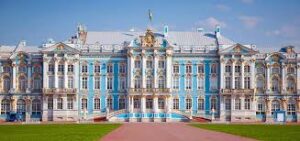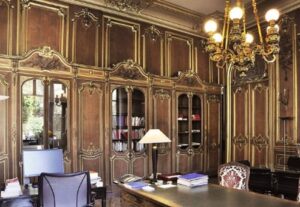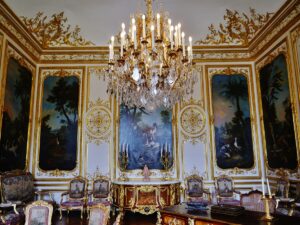Rococo Architecture
Rococo architecture was a lighter, more graceful, yet also more elaborate version of Baroque architecture, which was ornate and austere. While the styles were similar, there are some notable differences between both Rococo and Baroque architecture, such as symmetry; Rococo emphasized the asymmetry of forms, while Baroque was the opposite. The styles, despite both being richly decorated, also had different themes; the Baroque was more serious, placing an emphasis on religion, and was often characterized by Christian themes (the Baroque began in Rome as a response to the Protestant Reformation); Rococo architecture was an 18th century, more secular, adaptation of the Baroque that was characterized by more light-hearted and jocular themes. Other elements belonging to the architectural style of Rococo include numerous curves and decorations, as well as the use of pale colors.
There are numerous examples of Rococo buildings as well as architects. Among the most famous include the Catherine Palace in Russia, the Queluz National Palace in Portugal, the Augustusburg and Falkenlust Palaces in Brühl, the Chinese House in Potsdam, the Charlottenburg Palace in Germany, as well as elements of the Château de Versailles in France. Architects who were renowned for their constructions using the style include Francesco Bartolomeo Rastrelli, an Italian architect who worked in Russia and who was noted for his lavish and opulent works, Philip de Lange, who worked in both Danish and Dutch Rococo architecture, or Matthäus Daniel Pöppelmann, who worked in the late Baroque style and who contributed to the reconstruction of the city of Dresden in Germany.
Rococo architecture also brought significant changes to the building of edifices, placing an emphasis on privacy rather than the grand public majesty of Baroque architecture, as well as improving the structure of buildings in order to create a more healthy environment.
In 1733, Empress Elizabeth commissioned Mikhail Zemtsov and Andrei Kvasov to expand the Catherine Palace. Empress Elizabeth, however, found her mother’s residence outdated and incommodious and in May 1752 asked her court architect Bartolomeo Rastrelli to demolish the old structure and replace it with a much grander edifice in a flamboyant Rococo style. Construction lasted for four years, and on July 30, 1756 the architect presented the brand-new 325-meter-long palace to the Empress, her dazed courtiers, and stupefied foreign ambassadors.

Rococo Salons
The Rococo interior reached its height in the total art work of the salon. Rococo salons are known for their elaborate detail, serpentine design work, asymmetry and predisposition to lighter, pastel, or gold-based color palettes.
In 18th century Europe, the Rococo style became prevalent in interior design, painting, sculpture, and the decorative arts. A reaction to the rigidity of Baroque style, the frivolous and playful Rococo first manifested itself with interior design and decorative work. In French, the word salon simply means living room or parlor, and Rococo salons refer to central rooms that are designed in the Rococo style. In addition, the notion of the ‘salon’ is an Enlightenment era ideal that transformed the living room into the central space for aristocracy to entertain guests and engage in intellectual conversation. The idea that one’s architectural surroundings should encourage a way of life, or reflect one’s values, was the philosophy of the time.

As another means of reflecting status, furniture rose to new heights during the Rococo period, emphasizing the lighthearted frivolity that was prized by the style. Furniture design became physically lighter, so as to be easily moved around for gatherings, and many specialized pieces came to prominence, such as the fauteuil chair, the voyeuse chair, and the berger et gondola. Furniture in the Rococo period was freestanding, as opposed to wall-based, in order to accentuate the lighthearted and versatile atmosphere that was desired by the aristocracy. Mahogany became the most widely used medium due to its strength, and mirrors also became increasingly popular.


